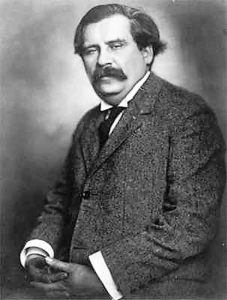Paprika is in the air is the title of a collection of essays, short stories and articles written by Zsigmond Móricz, early-20th century writer and columnist. Móricz was non-native to Szeged, only a visitor, but the city captured him physically and mentally as he kept returning and writing about the city and its people. As a columnist he had deep interest in social, political and economic issues. As a literary writer he was brilliant in capturing life and people artistically and describing it in a delightful way. He spoke in brilliant voice.

Zsigmond Móricz, the writer of Paprika is in the air series
Móricz’s series of writings on Szeged, its people and paprika culture proved to be invaluable insights into life in Szeged before the second world war. What can a paprika historian like PaprikaMolnár’s Paprika Museum writer do other than check statistics, newspapers and research papers? Thanks to Móricz, we have this beautifully written series of Paprika is in the air, and through the stories we get a rare chance to see people, life, views, impressions and stories of Szeged’s past that’s long gone.
For English language summary of the short stories in Paprika is in the air, you may read our earlier posts at the links below:
Móricz loved to sit and talk to local people, seek out what they were like, what made them Szegedi, or to see what traits they had from pre-Flood times, if they had any. Some of the characters are not good like in Szeged slippers, where Móricz visits a poor slipper-making family and finds proverty can be mean. But he digs deep and finds gem beyond the glittery avenues in Paprika is in the air II. or in The Szegedi bagpiper.
In August 1936, at the height of paprika industry, he takes account of the people in paprika business: growers, processors, millers and tradesmen. His statistics are invaluable for a paprika historian, but most interesting is his attempt at understanding the players’ motives, for exampe the speculations and sentiments related to extensive state regulations on paprika business.
Later the same year he goes deep into Paprika Town and marvels at the sight of red people in red clothes, with red hair, red hands and faces. Like red ghosts in daylight, he described the sight of paprika millers and processors in Szeged.
Probably the funniest of the writings is about the sassy Auntie Agnes. In 1940 Móricz goes to the Szeged central marketplace in front of the Town Hall, where he meets 70-year-old street vendor Auntie Agnes. Read the story to learn about why Auntie Agnes has to go to the police station.

Szeged Marketplace, where Auntie Agnes was vending
Tetszett a cikk? Ha szeretne még paprikás és fűszeres témában, heti rendszerességgel cikket olvasni, hírt kapni az ÚJ paprika elkészültéről, iratkozzon fel hírlevelünkre. Subscribe to our Blog and enjoy our Paprika Poster.






